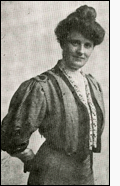Oregon Organizing Country Children
By Musa Geer
 After my first couple of years at Goodnoe Hills I went down to Salem. I had a clerkship at the Oregon legislature and I had quite a bit of leisure time and access to a typewriter, so I wrote a little article (it was just enough to fill one page) and sent it to Doubleday & Page, with whom I was acquainted, in New York. It was published in The World's Work, and I took my check to Goldendale for deposit in the Brooks & Co. bank.
After my first couple of years at Goodnoe Hills I went down to Salem. I had a clerkship at the Oregon legislature and I had quite a bit of leisure time and access to a typewriter, so I wrote a little article (it was just enough to fill one page) and sent it to Doubleday & Page, with whom I was acquainted, in New York. It was published in The World's Work, and I took my check to Goldendale for deposit in the Brooks & Co. bank.
It was the first money I had earned from writing, and it was a little story about school gardens. I had known about the work of Mr. Alderman, who was the superintendent in Polk county, in starting the school garden idea—it was while I was teaching at Salem, in Marion county. I told about a little boy (he was just 12) who baked the best cake. I remember I got three cents a word for that story.
After the story appeared, Mr. Alderman, who then was Superintendent of Schools in Portland, wrote me and asked me to teach in the Portland schools. I taught one year there, in the Woodstock school. I used to ride the train up to Goodnoe Hills and spend the weekends. (From "The Goodnoe Hills and Musa Geer" as told to Pete May - 1961)
Less than ten years ago, State Superintendent Alderman, in a little Yamhill County school in Oregon, saw the children of the school taking up a collection to buy popcorn. At the same time, he saw a plot of vacant ground near the schoolhouse, and it occurred to him that they might better raise the popcorn than buy it.
From that idea 60,000 children have become better citizens. They have raised not only popcorn, but chickens, pigs, melons, potatoes, asters, roses, almost everything that grows.
The State Bankers' Association, when they heard of the idea, called it "earth education" and lent their aid to it. Two years later, Mr. O. M. Plummer, secretary and treasurer of the Portland Union Stock Yards, became convinced of the value of the children's work and through his organization, helped to publish fifty thousand copies of a booklet that gave practical and scientific information on "How to Raise Prize-Winning Pigs." At the same time, the Commercial Club of Portland put out a similar publication on "Boys and Girls on the Egg Problem." Both these booklets were distributed to the pupils in all parts of the state.
Superintendent Alderman wrote the teachers a letter in which he said:
Ask the children if they know how to grow potatoes, pumpkins, corn, etc. Ask how many of them like watermelons or muskmelons. Ask them if they know how to feed chickens; if they know that if they buy three settings of egg from one neighbor and three hens from another, and in March put the two together, they will probably raise some prize winners for the fair. The children of Oregon can double the egg production in three years.
A marvelous interest was awakened in the boys and girls of Oregon. Gardens were laid out at home and at school. Good work brought good results and gained the hearty support of the parents. Many prejudices were broken down and, without realizing it, the fathers learned from the boys much that was efficient.
In the meanwhile the Oregon Agricultural College, the cooperating influence between the Oregon farmers and the scientists, established the "extension farm movement." This not only aids the parents, but helps the children. Provision was made by the college for a fieldworker to visit farming centers all over the state. Information was given out telling about ways to increase acreage yield, rotation of crops, better market facilities, more economical and better cooking.
The schools soon became the social centers, where a community spirit grew. This year lantern slides and phonographic records of the world's good music will instruct and entertain these gatherings.
The Oregon State Fair, in 1912, spent $3,500 in prizes for school industrial work. The railroads and electric lines gave free transportation to all displays that were made by the children. One little girl, who lived off the railroad, wheeled her prize-winning chickens two miles in a baby buggy to the fair. Another little girl. seven years old, put thirty dollars in the bank after the fair was over—her net profits from a fifteen-dollar prize on a trained colt, a five-dollar prize for the biggest watermelon, and other cash prizes for vegetable displays. The best cake was baked by a twelve-year old boy.
The Oregon legislature of 1913 passed a measure providing an appropriation to defray the expenses and salaries of two industrial fieldworkers, who are to visit every county in the state, make a study of representative schools in every county, and file reports of existing conditions with the State Superintendent of Public Instruction. One result of the hog-raising contest in 1912 was that enough pigs were raised by the boys and girls to supply the Portland Union Stock Yards for three months without any outside help.

